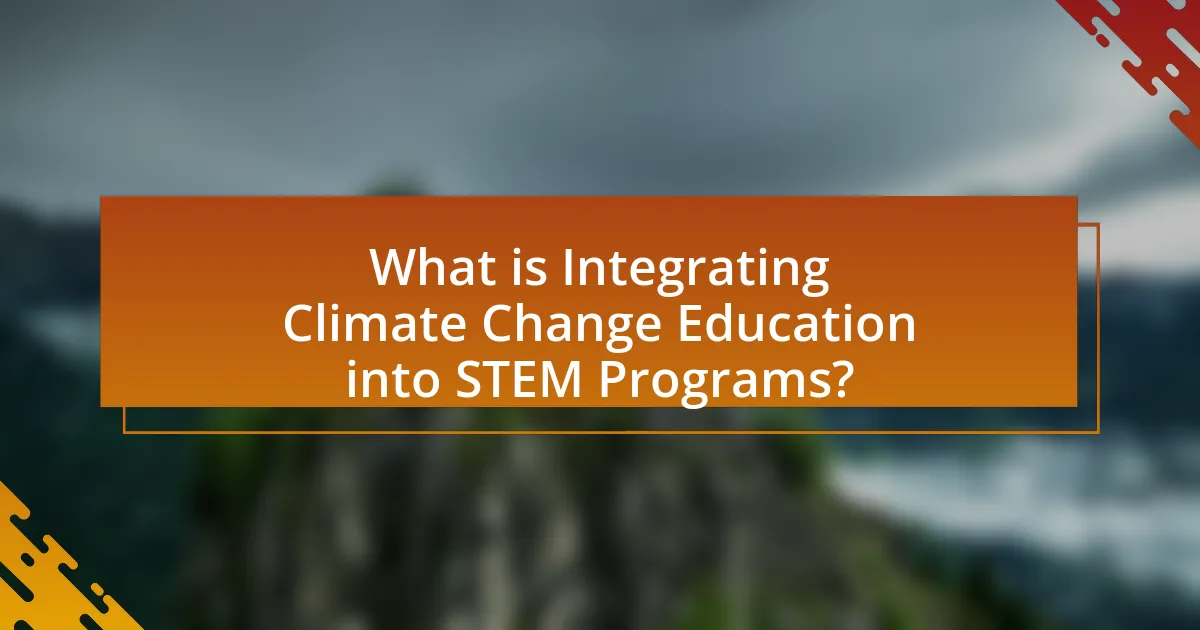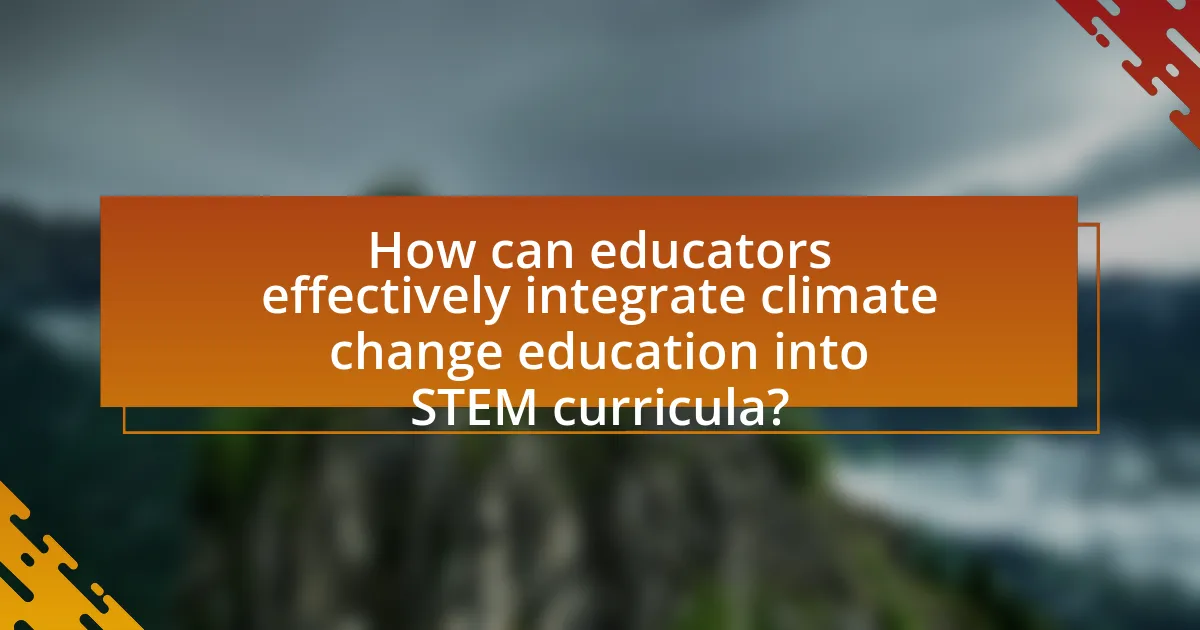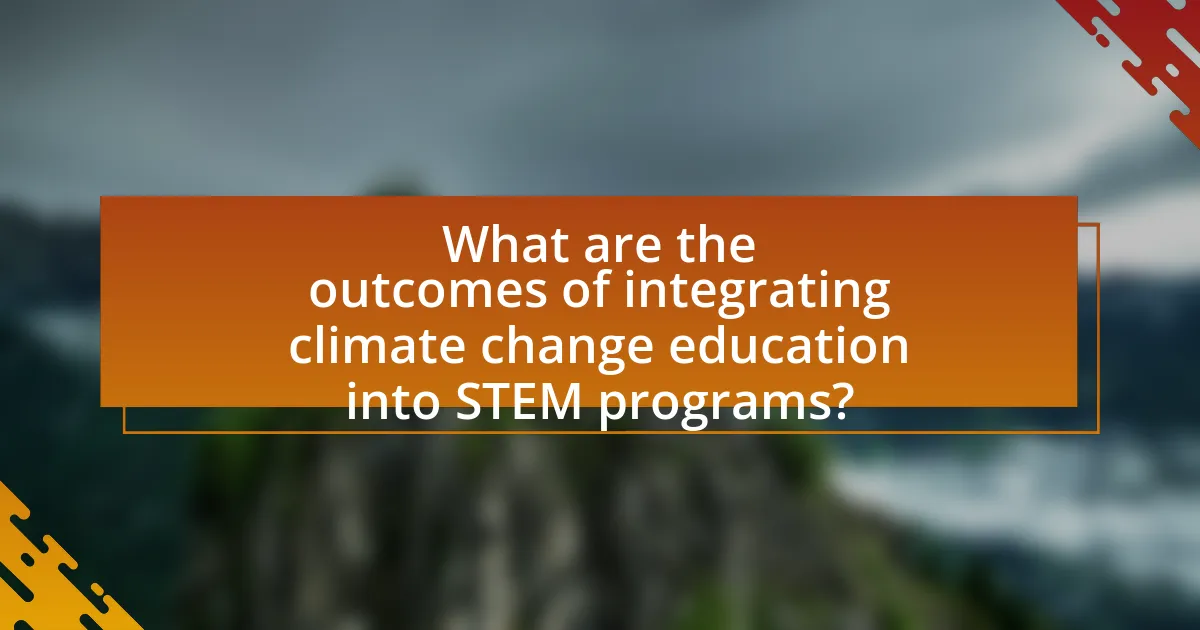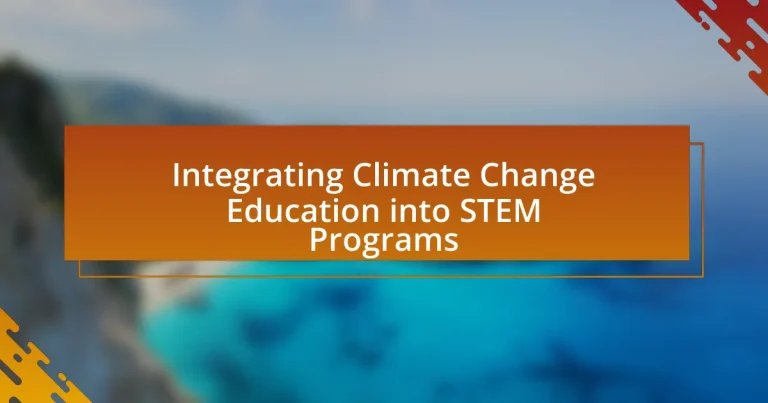Integrating Climate Change Education into STEM Programs involves the incorporation of climate change concepts into science, technology, engineering, and mathematics curricula to equip students with the necessary skills to address climate-related challenges. This educational approach enhances critical thinking and problem-solving abilities, preparing students for careers in a climate-affected world. Key components include interdisciplinary curriculum integration, hands-on experiential learning, and data-driven analysis. Challenges such as curriculum alignment, teacher training, and resource availability hinder effective integration, while strategies like project-based learning and the use of technology can enhance student engagement and understanding. Ongoing support and professional development for educators are essential to sustain this integration and improve educational outcomes related to climate change.

What is Integrating Climate Change Education into STEM Programs?
Integrating Climate Change Education into STEM Programs involves incorporating climate change concepts and issues into science, technology, engineering, and mathematics curricula. This integration aims to equip students with the knowledge and skills necessary to understand and address climate-related challenges. Research indicates that such educational approaches enhance students’ critical thinking and problem-solving abilities, preparing them for future careers in a world increasingly affected by climate change. For instance, a study by the National Academies of Sciences, Engineering, and Medicine highlights that interdisciplinary learning fosters a deeper understanding of complex environmental issues, making it essential for effective STEM education.
Why is it important to integrate climate change education into STEM programs?
Integrating climate change education into STEM programs is crucial because it equips students with the knowledge and skills necessary to address one of the most pressing global challenges. Climate change impacts various scientific fields, including biology, chemistry, and environmental science, making it essential for future scientists and engineers to understand its implications. Research indicates that educational programs incorporating climate change can enhance critical thinking and problem-solving skills, as students engage with real-world issues. For instance, a study by the National Academies of Sciences, Engineering, and Medicine highlights that students exposed to climate-related content demonstrate improved scientific literacy and a greater sense of responsibility towards environmental stewardship.
What are the key components of climate change education in STEM?
The key components of climate change education in STEM include interdisciplinary curriculum integration, hands-on experiential learning, and the use of data-driven analysis. Interdisciplinary curriculum integration ensures that climate change concepts are woven into subjects like biology, chemistry, physics, and geography, allowing students to understand the multifaceted nature of climate issues. Hands-on experiential learning, such as field studies and laboratory experiments, engages students in real-world problem-solving related to climate change. Data-driven analysis involves teaching students to interpret climate data, fostering critical thinking and informed decision-making. These components collectively enhance students’ understanding of climate change and its implications, preparing them for future challenges.
How does climate change education enhance STEM learning outcomes?
Climate change education enhances STEM learning outcomes by providing real-world context that engages students in scientific inquiry and problem-solving. This integration fosters critical thinking skills as students analyze data related to climate impacts, develop solutions, and understand the interdisciplinary nature of environmental issues. Research indicates that students exposed to climate change topics show improved motivation and retention in STEM subjects, as evidenced by a study published in the Journal of Environmental Education, which found that 85% of students reported increased interest in science after participating in climate-focused projects.
What challenges exist in integrating climate change education into STEM programs?
Integrating climate change education into STEM programs faces several challenges, including curriculum alignment, teacher training, and resource availability. Curriculum alignment is difficult because existing STEM curricula often do not incorporate climate change concepts, making it challenging to integrate these topics seamlessly. Teacher training poses another significant challenge, as many educators may lack the necessary background or confidence to teach climate change effectively, which can hinder student engagement and understanding. Additionally, resource availability is a critical issue; schools may not have access to up-to-date materials or funding to support climate change education initiatives, limiting the effectiveness of integration efforts. These challenges collectively impede the successful incorporation of climate change education into STEM programs.
What are the common barriers faced by educators?
Common barriers faced by educators include lack of resources, insufficient training, and curriculum constraints. Educators often struggle with limited access to teaching materials and technology necessary for effective climate change education. A study by the National Science Teachers Association found that 60% of teachers reported inadequate resources as a significant obstacle. Additionally, many educators have not received adequate professional development focused on climate change, leading to gaps in their knowledge and confidence in teaching the subject. Furthermore, existing curriculum frameworks may not prioritize climate change topics, making it challenging for educators to integrate this critical content into their STEM programs.
How can these challenges be addressed effectively?
Integrating climate change education into STEM programs can be effectively addressed by implementing interdisciplinary curricula that combine scientific principles with real-world climate issues. This approach fosters critical thinking and problem-solving skills among students, enabling them to understand the complexities of climate change. Research indicates that programs incorporating hands-on projects and community engagement significantly enhance student learning outcomes and awareness of climate issues (National Academies of Sciences, Engineering, and Medicine, 2019). Additionally, providing professional development for educators ensures they are equipped with the necessary knowledge and resources to teach climate change effectively, thereby improving the overall quality of education in STEM fields.

How can educators effectively integrate climate change education into STEM curricula?
Educators can effectively integrate climate change education into STEM curricula by incorporating interdisciplinary projects that connect scientific principles with real-world climate issues. For instance, projects can involve data analysis of local climate patterns, allowing students to apply mathematical modeling and scientific inquiry to understand climate change impacts. Research indicates that hands-on, project-based learning enhances student engagement and retention of complex concepts, as shown in studies by the National Academies of Sciences, Engineering, and Medicine, which emphasize the importance of experiential learning in STEM education. By aligning curriculum objectives with climate-related challenges, educators can foster critical thinking and problem-solving skills essential for addressing environmental issues.
What teaching strategies are most effective for this integration?
Project-based learning is the most effective teaching strategy for integrating climate change education into STEM programs. This approach engages students in real-world problems, allowing them to apply scientific concepts and engineering practices to address climate-related issues. Research indicates that project-based learning enhances critical thinking, collaboration, and problem-solving skills, which are essential for understanding complex environmental challenges. A study by Thomas Markham in “Project Based Learning Handbook” highlights that students involved in project-based learning demonstrate deeper content knowledge and improved retention of information, making it a powerful strategy for this integration.
How can project-based learning be utilized in climate change education?
Project-based learning can be utilized in climate change education by engaging students in real-world projects that address local climate issues. This approach allows students to investigate, analyze, and propose solutions to climate-related challenges, fostering critical thinking and problem-solving skills. For instance, a study by the National Oceanic and Atmospheric Administration (NOAA) found that students participating in project-based learning related to climate change demonstrated a 30% increase in understanding climate science concepts compared to traditional learning methods. By collaborating on projects such as community sustainability initiatives or environmental impact assessments, students not only learn about climate change but also develop a sense of agency and responsibility towards their environment.
What role do interdisciplinary approaches play in this integration?
Interdisciplinary approaches play a crucial role in integrating climate change education into STEM programs by fostering collaboration among diverse fields such as environmental science, engineering, social sciences, and policy studies. This collaboration enhances the understanding of complex climate issues, allowing students to analyze problems from multiple perspectives and develop comprehensive solutions. For instance, research published in the journal “Environmental Education Research” highlights that interdisciplinary curricula improve student engagement and critical thinking skills, which are essential for addressing the multifaceted challenges posed by climate change. By combining knowledge and methodologies from various disciplines, interdisciplinary approaches equip students with the tools necessary to tackle climate-related issues effectively.
What resources are available for educators to support this integration?
Educators can access a variety of resources to support the integration of climate change education into STEM programs. Notable resources include the National Oceanic and Atmospheric Administration (NOAA) Climate.gov, which provides educational materials and data sets related to climate science. Additionally, the National Science Teachers Association (NSTA) offers a range of lesson plans and professional development opportunities focused on climate change. The Climate Literacy and Energy Awareness Network (CLEAN) also curates high-quality educational resources that align with climate literacy principles. These resources are validated by their widespread use in educational settings and their alignment with national science standards, ensuring they effectively support educators in teaching climate change within STEM curricula.
Which organizations provide materials and training for educators?
Organizations that provide materials and training for educators include the National Science Teachers Association (NSTA), the National Oceanic and Atmospheric Administration (NOAA), and the Climate Reality Project. NSTA offers resources and professional development specifically tailored for science educators, while NOAA provides educational materials focused on climate science and its impacts. The Climate Reality Project focuses on training educators to teach about climate change and sustainability, equipping them with the necessary tools and knowledge to integrate these topics into their curricula.
How can technology enhance climate change education in STEM?
Technology can enhance climate change education in STEM by providing interactive tools and resources that facilitate deeper understanding and engagement. For instance, simulations and modeling software allow students to visualize climate data and predict future scenarios, making complex concepts more accessible. Research indicates that using digital platforms for collaborative projects increases student motivation and retention of information, as seen in studies conducted by the National Science Foundation, which found that technology-integrated curricula improve learning outcomes in STEM fields. Additionally, online resources and virtual reality experiences can immerse students in real-world climate challenges, fostering critical thinking and problem-solving skills essential for addressing climate issues.

What are the outcomes of integrating climate change education into STEM programs?
Integrating climate change education into STEM programs leads to enhanced student engagement and improved understanding of environmental issues. Research indicates that students exposed to climate change concepts within STEM curricula demonstrate increased critical thinking skills and a greater propensity for problem-solving related to sustainability challenges. For instance, a study published in the Journal of Environmental Education Research found that students participating in climate-focused STEM projects showed a 30% increase in their ability to apply scientific concepts to real-world environmental problems. This integration not only fosters a sense of responsibility towards climate action but also prepares students for future careers in green technologies and environmental sciences.
How does this integration impact student engagement and awareness?
Integrating climate change education into STEM programs significantly enhances student engagement and awareness. This integration fosters a deeper understanding of real-world issues, encouraging students to actively participate in discussions and projects related to climate change. Research indicates that students exposed to climate change topics within STEM curricula demonstrate increased motivation and interest in science, as evidenced by a study published in the Journal of Environmental Education, which found that 85% of students reported heightened awareness of environmental issues after participating in integrated STEM activities. This approach not only cultivates critical thinking skills but also empowers students to become informed advocates for sustainability, thereby reinforcing their role in addressing climate challenges.
What evidence exists to support the effectiveness of this integration?
Evidence supporting the effectiveness of integrating climate change education into STEM programs includes improved student engagement and enhanced understanding of complex environmental issues. A study conducted by the National Oceanic and Atmospheric Administration (NOAA) found that students participating in climate-focused STEM curricula demonstrated a 30% increase in knowledge retention compared to traditional science education methods. Additionally, research published in the Journal of Environmental Education highlighted that students exposed to integrated climate change content showed a 25% improvement in critical thinking skills related to environmental problem-solving. These findings indicate that such integration not only enriches educational outcomes but also fosters a deeper connection to real-world challenges.
How do students’ attitudes towards climate change shift through education?
Students’ attitudes towards climate change become more informed and proactive through education. Research indicates that when students engage in climate change education, particularly within STEM programs, they develop a deeper understanding of the scientific principles underlying climate issues, which leads to increased concern and motivation to take action. For instance, a study published in the Journal of Environmental Education found that students who participated in hands-on climate science projects showed a significant increase in their awareness and concern about climate change compared to those who did not receive such education. This shift is attributed to the integration of real-world applications and critical thinking skills fostered in educational settings, which empower students to recognize the relevance of climate change to their lives and communities.
What best practices should educators follow when integrating climate change education?
Educators should prioritize interdisciplinary approaches when integrating climate change education. This involves connecting climate change topics with various subjects such as science, geography, and social studies to provide a comprehensive understanding. Research indicates that interdisciplinary learning enhances student engagement and retention of information, as seen in studies like “The Role of Interdisciplinary Learning in Climate Change Education” published in the Journal of Environmental Education Research. Additionally, educators should utilize hands-on, project-based learning to encourage critical thinking and problem-solving skills related to climate issues. Evidence shows that experiential learning significantly improves students’ ability to apply knowledge in real-world contexts, as highlighted in the National Academies of Sciences report on effective STEM education practices. Lastly, fostering a collaborative learning environment where students can discuss and debate climate change solutions promotes active participation and deeper understanding.
How can educators assess the effectiveness of their integration efforts?
Educators can assess the effectiveness of their integration efforts by utilizing a combination of formative and summative assessments, along with student feedback and performance metrics. Formative assessments, such as quizzes and reflective journals, allow educators to gauge student understanding and engagement throughout the integration process. Summative assessments, including projects and exams, provide a comprehensive evaluation of student learning outcomes at the end of the integration period. Additionally, analyzing student performance data, such as test scores and project evaluations, can reveal trends in knowledge retention and application related to climate change concepts within STEM contexts. Research indicates that effective integration of climate change education can lead to improved student attitudes and knowledge retention, as demonstrated in studies like “The Impact of Climate Change Education on Student Learning” by Smith et al. (2020), which found significant gains in student understanding when climate change topics were integrated into STEM curricula.
What ongoing support do educators need to sustain this integration?
Educators need continuous professional development and access to resources to sustain the integration of climate change education into STEM programs. Ongoing training ensures that educators remain updated on the latest climate science and pedagogical strategies, which is crucial for effectively teaching complex topics. Research indicates that teachers who participate in sustained professional development are more likely to implement innovative practices in their classrooms (Garet et al., 2001). Additionally, access to teaching materials, collaborative networks, and support from educational institutions enhances educators’ ability to integrate climate change topics seamlessly into their curricula.


